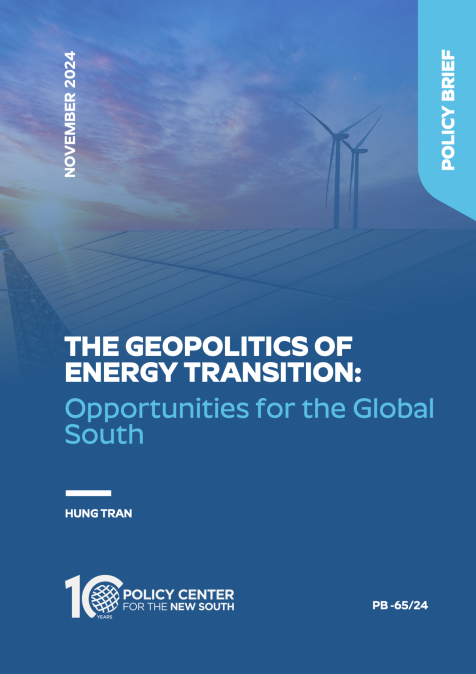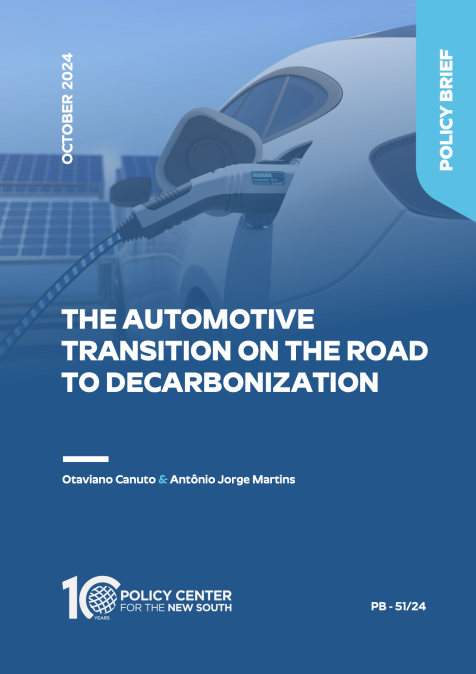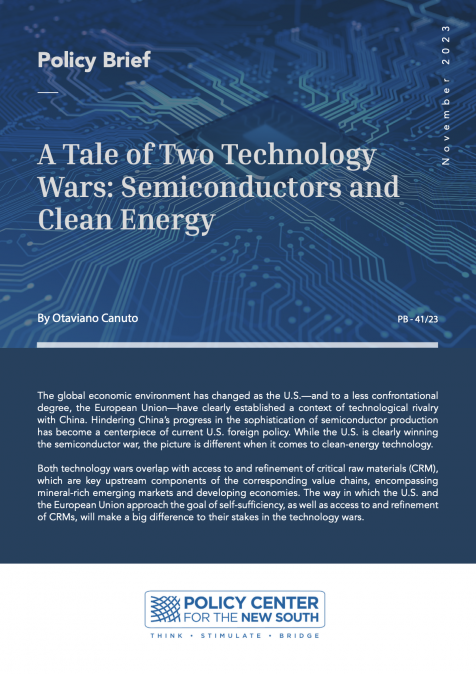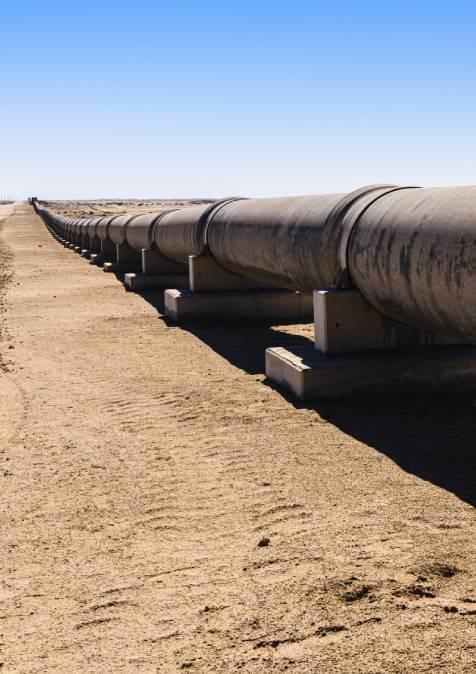Publications /
Policy Brief
In September 2024, scientists at the European Union’s Copernicus Climate Change Service reported that summer 2024 was the hottest on record globally, and the previous twelve months posted a average global temperature that was a record 1.64 degrees Celsius (2.95 degrees Fahrenheit) above the average during the pre-industrial period, 1850-1900. This was triggered by a combination of a warmer El Niño cycle and the effects of human-caused warming. While it will take more years of such scorching global temperatures to confirm that the world has failed to keep the temperature increase below 1.5 degrees Celsius, the currently hot weather has given a clear warning that efforts need to be significantly accelerated to meet the key target of keeping global warming below 2 degrees Celsius (3.6 degrees Fahrenheit), agreed at the COP21 in Paris in 2015. Exceeding the 1.5 degrees Celsius limit increase now appears to be unavoidable.
Introduction
The record temperature recently experienced has heightened urgency of global efforts to phase down coal, phase out inefficient fossil-fuel subsidies, and transition to clean energy including widespread uses of electric vehicles (EVs), solar panels and wind turbines—as agreed at the 2023 COP28 in Dubai. It is already a difficult proposition to move away from a global economy based on the use of fossil fuels, but heightened geopolitical rivalry has made the energy transition process even more daunting. In particular, the re-election of Donald Trump to a second term as U.S. President has raised the likelihood of escalating tension with China and disarray in international climate efforts, given Trump’s continued denial of climate change. He has vowed to take the U.S. out of the 2015 Paris Climate Agreement once again.
The challenges of the energy transition can be observed on three levels: first, competition to shape global supply chains for the critical minerals and products needed for green energy, driven by economic and national security concerns; second, divergences in national policies and regulations on climate mitigation and transition; and third, jockeying in international forums such as the annual Conference of the Parties of the United Nations Framework Convention on Climate Change (COP of the UNFCCC) to negotiate international commitments to deal with climate change, including the funding for mitigation and transition efforts.
Competition to Shape Global Supply Chains for Critical Minerals and Green Products
It is important to recognize that clean energy products including EVs, wind turbines, and solar panels use much more minerals than conventional products, according to the International Energy Agency (IEA).
For example, EVs require more than 200 kilograms of critical minerals per vehicle, compared to only 30 kilograms for conventional vehicles. In terms of kilograms of minerals per megawatt of power generated, offshore wind uses more than 15 kg, onshore wind more than 10 kg, solar almost 7 kg. By contrast, coal uses less than 3 kg, and natural gas just over 1 kg.
The critical minerals needed for clean-energy products include copper, lithium, nickel, manganese, cobalt, graphite, chromium, molybdenum, zinc, rare earth elements, and silicon.
The global race among major countries to secure access to these critical minerals has been greatly complicated by the geopolitical rivalry between China/Russia and the West. Of particular importance have been the derisking efforts of the U.S. and EU to reduce their reliance on China, given that China dominates the global supply chains for critical minerals—in general accounting for 60% of world production and 85% of world processing capacity.
China’s position differs at the various stages of mineral production chains. In upstream operations, minerals are extracted in resource-rich countries. China is a large country with abundant natural and mineral resources, but some, such as iron ore, are of low quality, requiring China to import iron ore. In particular China has the biggest reserve of rare earth elements (REEs) in the world; REEs consist of 17 metallic elements, four of which—neodymium, dysprosium, praseodymium, and terbium—are particularly important for green-energy technology. However, other countries have much larger reserves of other key minerals. For example, Australia and Chile account for 79% of global lithium reserves, the Democratic Republic of Congo has 70% of cobalt reserves, Chile and Peru 40% of copper, and Indonesia 30% of nickel.
As a result, China has invested substantially in strategic and resource-rich countries, mainly through the Belt and Road Initiative (BRI). This extends to Africa (mostly in Angola, Djibouti, Ethiopia, Kenya, DRC, and Zambia), Latin America (Brazil, Chile, Peru), Asia (Indonesia), and Eurasia (Mongolia). Through majority and minority equity positions or lending collateralized by mineral deliveries, China has secured access to significant amounts of various critical minerals around the world. In this context, it is important to note that Chinese state-owned companies have joined the list of the top 12 mining companies in the world, ranked by market capitalization. As a consequence, securing open shipping lanes has also become crucially important to China’s economic and national security.
More importantly, China dominates midstream and downstream stages of the mineral production process. In midstream operations (refining and processing), China refines 68% of minerals globally thanks to its low labor costs and lax environmental regulations. In particular, China accounts for the refining globally of 40% of copper, and 73% of cobalt.
In downstream operations making fine particles ready to be used, China is also dominant. For example, in battery cell components, China accounts for 79% of cathodes (making up half of the cost of batteries), 85% of anodes, 66% of separators, and 62% of electrolytes. China also has three quarters of the world’s mega factories for lithium-ion batteries—accounting for 80% of global capacity.
Leveraging its dominance in batteries, China has become the top manufacturer of EVs , or 58% of the global total, in 2023. China has achieved the objectives laid down in its development plan more than 10 years ago, supporting the launch of hundreds of EV startups, and then subjecting them to fierce competition to eventually end up with a dozen or so producers with brand-name recognition. Out of these winners, BYD has surpassed Tesla to become the world’s top EV company.
Another consequence of China’s approach has been overcapacity at home, leading to a surge in exports of Chinese EVs and other green products. Chinese EV companies have started to outcompete Western EV producers in their own markets with low-priced, good-quality EVs. This has heightened trade tensions, with the U.S. and others imposing anti-dumping duties on Chinese EVs. The US has imposed tariffs of 25%-100% (which could be raised under the incoming Trump administration). The EU has announced tariffs of up to 45% on Chinese EVs. Canada has also set its tariff at 100%. Furthermore, fellow Global-South country Brazil increased tariffs on Chinae EVs to 20% in 2024, rising to 35% in 2026. In short, trade war between China and the West and others looms as China nears a record $1 trillion trade surplus in 2024.
China has dominated the world’s market for solar panels, with a more than 80% market share. China has also gained strong competitive advantage in producing wind turbines and components, both on- and off-shore, fielding five out of the world’s six top producers. In 2023, China drove the significant 36% increase in global wind power generation capacity to 118 GW, accounting for 65% of global wind power capacity. Furthermore, Chinese companies commissioned 1.7 GW of wind power projects in 20 foreign countries, offering prices 20% lower than those of Western companies.
China has made significant progress in rolling out electricity transmission grids at scale, gaining technological insights and management experience to help it compete better in international markets. Specifically in 2022, China invested $166 billion in its transmission grids, while the rest of the world collectively invested $118 billion.
As a result, according to a Brookings study, “the world is highly dependent on sourcing from China to advance the energy transition and meet decarbonization plans”.
De-risking Efforts
In addition to raising tariffs on Chinese EVs, to de-risk from heavy reliance on China in those critical minerals, the U.S. has launched the Sustainable Critical Mineral Alliance and the Mineral Security Partnership with allied and friendly countries, in order to diversify sources of supply. The U.S. has also passed the Infrastructure Law (2021) and the Inflation Reduction Act (IRA in 2022), to incentivize the domestic production of EVs and batteries.
The EU passed the Critical Raw Material Act (CRMA) in late 2023 to secure access to 34 critical materials necessary for the green energy transition. It is also in the process of negotiating a critical mineral agreement with the US to allow critical minerals extracted or processed in the EU to benefit from EV tax credits provided under the US IRA.
Also of note has been the G7’s Partnership for Global Infrastructure and Investment (PGII), launched in 2022 with pledges of $600 billion to invest in developing countries and competing with China’s BRI. The G7 also established the Just Energy Transition Partnership (JETP) in 2022, starting with South Africa, Indonesia, and Vietnam, to offer them financial support for ambitious decarbonization targets, phasing out the use of coal.
However, the Western approach sketched out above, especially G7 cooperation initiatives, has been put in serious doubt by the incoming Trump administration. It is likely that the U.S. will continue to de-risk from China, but through unilateral actions with less emphasis on collaboration with the EU and others. This could probably make these de-risking efforts, and also high-tech containment of China, less effective as they will not be carried out by a Western united front.
Conflicting Policy and Regulatory Regimes
In response to China’s state-led, long-term planning approach, the U.S. and EU have struggled to adopt measures to counter the dominance of China in the green-energy arena. At present there is clear divergence between the U.S. and the EU in regulating green-energy products.
The U.S. has set its net-zero emission goal by 2050, including reducing emission by 65% in 2030. It has a rather loose arrangement to promote that goal—with the Federal Energy Regulatory Commission encouraging U.S. utilities companies to implement long-term plans to access clean energy. Under President Biden, the U.S. taken the subsidy approach in its Infrastructure Law of 2021 and the Inflation Reduction Act (IRA) of 2022, promising tax incentives to companies producing these goods in the U.S., in particular EVs and batteries; and tax credits to consumers buying them. This is the embodiment of the U.S. government’s emphasis on rebuilding the country’s manufacturing base.
However, this has been seen as discriminatory by other producing economies—especially the EU—and has triggered a subsidy war. This situation is likely to change drastically as President-elect Trump has vowed to roll back Biden’s climate initiatives, dismantling many of the current environmental protection policies, regulations, rules, and agencies, including abandoning many parts of the IRA. Instead, the thrust of U.S. energy policy under Trump 2.0 would be to intensify fossil-fuel exploration and production, including by fracking, while weakening environmental protection at home and minimizing cooperation in international climate mitigation and transition efforts. This would deal a serious setback to international climate efforts, making it more difficult and taking more time to meet the agreed net-zero emissions target.
The EU on the other hand has been in the vanguard in using legislation and regulation to move society towards an ambitious net zero target by 2050 with a current proposal to achieve a 90% reduction by 2040. In addition to the rules mentioned above, the EU has passed the Carbon Border Adjustment Mechanism (CBAM) to impose a surcharge or tax on certain products from other countries that are not subject to a carbon price like equivalent EU domestic production, in order to maintain a level playing field for EU producers. Other countries, especially emerging markets, have criticized the CBAM as unilateral, protectionist, and discriminatory against them. Equally importantly, voters in many EU countries have complained about the increasing costs of those ambitious energy goals.
China released a White Paper on Energy Transition in August 2024, mapping out its strategy and targets for 2024-2049. It reaffirms the goal of reaching net-zero emissions by 2060 by continuing efforts to replace fossils fuels with renewable energy. In 2023, China invested $676 billion in the energy transition, or 38% of the global total. It had set a target of the production of 1,200 gigawatts of wind/solar power by 2030, but already met that goal in July 2024—six years ahead.
However, China still relies on coal for electricity generation, including for EVs. Consequently, it has lagged behind in cutting the carbon intensity of its economy—targeted to be reduced by 18% by 2030. Importantly, China has been the largest greenhouse-gas emitter in the world since the mid-2000s.
The most important point to keep in mind is that China views the energy transition as strategic in nature: designed to stimulate economic growth and to meet economic and national security objectives. Indeed, in recent years, the production of batteries, EVs, solar panels, and wind turbines has played a major role in sustaining the Chinese economy, keeping it close to the GDP growth target of around 5% per year.
Generally speaking, China is likely to mobilize resources to accelerate its energy-transition activities, while the U.S. will downgrade its efforts, and the EU is moving ahead with its ambitious plans but facing resistance from citizens weary of the high costs of clean energy.
The divergence and inherent conflicts in the approaches of the three major economic powers would increase the complexity and costs of the energy transition. In particular, the U.S. pro-fossil fuel policy under Trump poses a serious challenge for the rest of the world to coalesce around a plan B to proceed without the U.S., which is the second largest CO2 emitter after China.
Discord in International Climate Forums
Geopolitics will increase the level of discord in international climate forums, such as the Conferences of the Parties (COP), especially the COP29 which took place in Baku, Azerbaijan from November 11-22, 2024, and focused on climate finance beyond 2025. The likely reversal of U.S. climate policy—in particular the likely withdrawal of the US from the 2015 Paris Agreement for a second time—would greatly complicate the COP process. Basically, the agreements reached at the fractious the COP29 in Baku, Azerbaijan on November 11-22, 2024, especially the $300 billion climate financing target to help developing countries, will likely be ignored by the incoming Trump administration. It would be more difficult for the rest of the world to mobilize the agreed financing, which has been strongly criticized as grossly inadequate to meet the need of at least $1.3 trillion a year as demanded by developing countries.
According to the Climate Policy Initiative, the world would need to invest up to $10 trillion a year up to 2050 to be able to meet the net-zero emissions target. Yet the annual climate fund flows have been $1.3 trillion—well below what’s needed.
The agreed financing initiatives have all underperformed and have fragmented into more than a dozen funds and entities. The main UN Green Climate Fund (GCF), made operational by the 2015 Paris Accord, to help vulnerable countries cope with the impacts of climate change, has disbursed $4.6 billion of grants and investments, out of the $16 billion committed by donor countries. The U.S. contributed $2 billion during the initial mobilization of resources, and has pledged $3 billion more for the second GCF Replenishment (2024-2027). This pledge is likely to be reversed by the Trump administration. Importantly, it is not clear if China has contributed to the GCF, and if so, how much. This uncertainty arises from China’s claim that as a developing country it does not bear the responsibility of contributing to international climate finance, even though it has become the top CO2 emitter. This could become a main point of contention with other donor countries, largely from the developed world.
The 2009 agreement that developed countries mobilize $100 billion a year to help developing countries in their climate change efforts has been repeatedly delayed, and was ultimately declared achieved by the OECD in 2022. But it has been pointed out that one-third of the funding has included money diverted from existing development budgets, not net new money.
More recently, the Loss and Damage Fund agreed to at COP28 in Dubai has managed to get about $700 million of pledges—with a small contribution from the U.S. and none from China. This modest amount is hardly sufficient to meet the Fund’s objectives, estimated to require between $300 billion to $671 billion annually.
Generally speaking, going forward, the COP process and other international climate initiatives will be shaped not only by geopolitical rivalry but also by the reversal of the U.S. climate approach, making progress increasingly uncertain. What is less uncertain is that the U.S.-China geopolitical rivalry will be more intense.
Opportunities for Global South Countries
The outlook described above—more intense rivalry between China and the U.S., which would withdraw from international climate activities—would open up opportunities for Global South countries to strengthen their relative roles in world affairs. In particular, the vacuum created by the U.S.’s renewed exit from the 2015 Paris Climate Agreement would allow China to claim leadership of the international climate movement to promote its strategic interests, very much like the way Xi Jinping championed globalization and free trade in Davos in 2017, while Trump built barriers. However, China’s continued reliance on coal while being the top emitter, plus its reluctance to contribute to multilateral funding of climate finance to assist developing countries, would hinder to some extent its claim to climate leadership.
Meanwhile, Europe can be expected to feel pressured by China’s advances in clean-tech products, and isolated by the U.S. move away from dealing with climate change, becoming isolationist and unilateral. As a consequence, both Europe and China could intensify their efforts to court Global South countries to strengthen their geopolitical positions. It is not clear at this juncture how the Trump administration will approach Global South countries in the geopolitical context—his emphasis probably will not be on building alliances.
In any event, the dynamics of the developments described above would give Global South countries some leverage in dealing with other economies, especially Europe and China, securing better trade and investment deals for themselves, and in the process helping to change the practices and rules of the international economic system to better serve the development interests of developing countries.
In particular, Global South countries can better leverage their abundant mineral resources to drive hard bargains with the competing blocs—the U.S./Europe and China/Russia—for useful investment and trade deals. The Global South emphasis should be on attracting more mid- and downstream investments to move Global South countries up the mineral production value chains from simple extraction. This should be parts of the new growth strategies of Global South countries. Indonesia has already embarked on such an approach with its nickel deposits. Its experiences so far offer useful lessons to other Global South countries.
Moreover, Global South countries, especially in Africa, should take advantage of China’s competitively priced green-energy products, such as solar panels, to develop their solar energy sectors, given Africa’s abundance of sunshine. This would help address the lack of access to reliable energy that millions of Africans face, and would open up opportunities to export solar-based electricity to Europe.
The prerequisite for the Global South to be able to take a more assertive approach rests on the ability of developing countries to coordinate their strategies, in particular their mineral policies in negotiations with potential foreign partners that want to invest and develop their natural resources. This was recognized in the Kazan Declaration from the October 2024 BRICS Summit in Russia. Taking note of the abundance of mineral resources, including critical resources, in member countries, the BRICS will launch a Geological Platform “as a first step of practical collaboration in the field of geology and rational development of mineral resources”.
Another example of the awareness in Global South countries of the importance of mineral reserves is the African Union’s adoption of its African Mining Vision and establishment of the African Minerals Development Center, “to promote the transformative role of mineral resources in the development of the continent”. Progress in Global South cooperation would put it in a strong position in dealing with the two blocs competing for support to secure access to critical minerals in the Global South.
Equally importantly, Global South countries, with the coordination of the G77+China, have made progress in coordinating their positions—notably helping to push for the launch of the Loss and Damage Fund at COP28 in Dubai in 2023. At COP29, the group argued for a New Collective Quantified Goal for climate finance to replace the $100 billion per year support agreement, which has been viewed as grossly inadequate. New estimates have put the costs of implementing the nationally determined commitments made by developing countries, to achieve net zero, at $5.8 trillion through 2050, most of which the G77 has argued should come from large emitters in the developed world. However, China’s claim of developing-country status to avoid being a provider of climate funding will be a point of contention, especially with developed countries.
In an early achievement, the COP29 agreed—with support of Global South countries—the international carbon market standards for Article 6.4 of the Paris Agreement, a key step in setting out binding rules for trading among countries of “internationally transferable mitigation outcomes” (ITMOs), or carbon offset credits. The international carbon market would allow a country or company to offset some of its emission by paying for climate mitigation or transition activities elsewhere, especially in developing countries.
Conclusions
While the international situation has become quite uncertain, two things stand out.
First, the West’s geopolitically driven de-risking efforts to put up tariffs and limit the spread of Chinese competitively priced clean-tech products would materially increase the costs and availability of those products. Wood MacKenzie, a consulting firm, has estimated that excluding Chinese clean-tech products from world markets would add $6 trillion on top of the $29 trillion in capital expenditures likely to be required through 2050 to reach the net zero target—or 20% more than expected.
Second, the reversal of the U.S. climate approach to that of denial would significantly complicate and delay efforts by the rest of the world to move to net zero. The rest of the world will struggle to find a way forward without the U.S. In this context, the role of the Global South would be strengthened in shaping a new and more inclusive multilateralism among countries still aiming to reach the net-zero target. However, the fight over who should pay for climate mitigation and transition efforts, especially in developing countries, would be even more difficult.
Given the hot temperatures experienced recently, the goal of keeping the increase in global surface temperatures below 2 degrees Celsius is likely to become more challenging. In that context, potential climate damages in developing countries, especially the low-income countries, would increase, forcing those countries to get their acts together to deal with climate change. They will have to cooperate and coordinate with peers in the Global South to protect their development interests. The increasingly complex international situation, especially in dealing with climate change, therefore represents both a threat and an opportunity for developing countries to rise to the occasion to promote their common interests. Failure to do so would be devastating for their people, an increasing number of whom have already fallen into extreme poverty because of the polycrisis in recent years.









